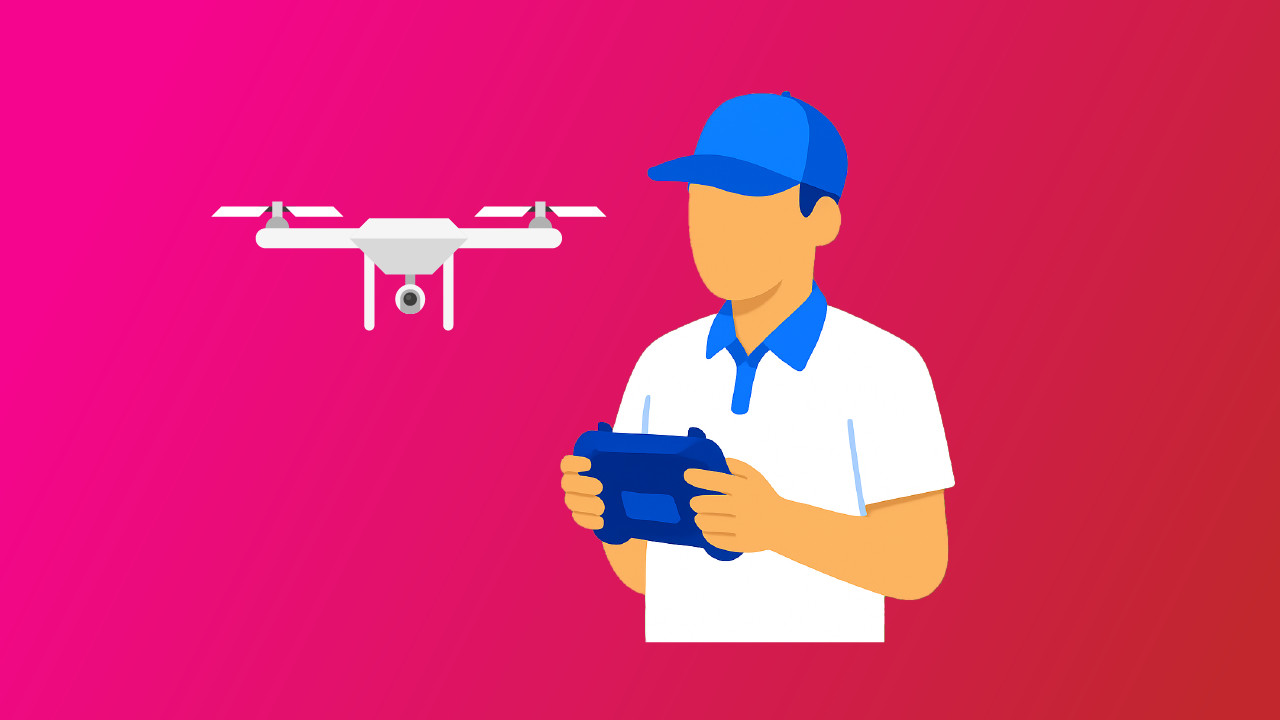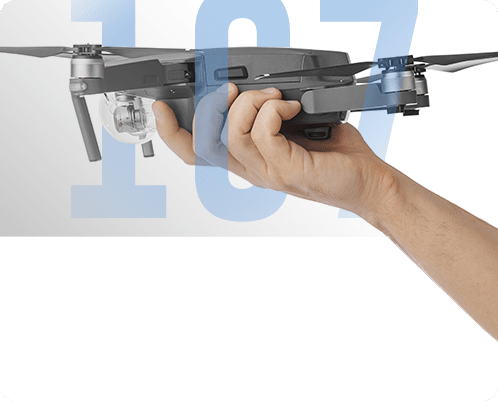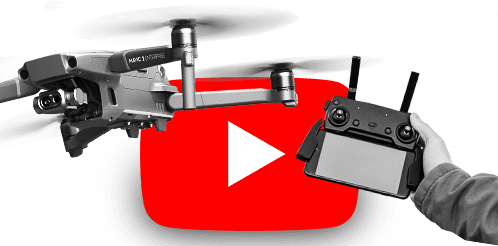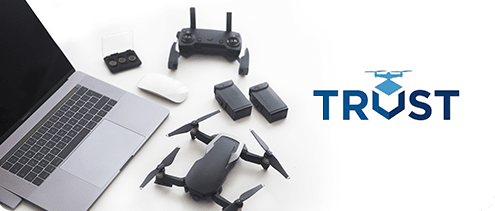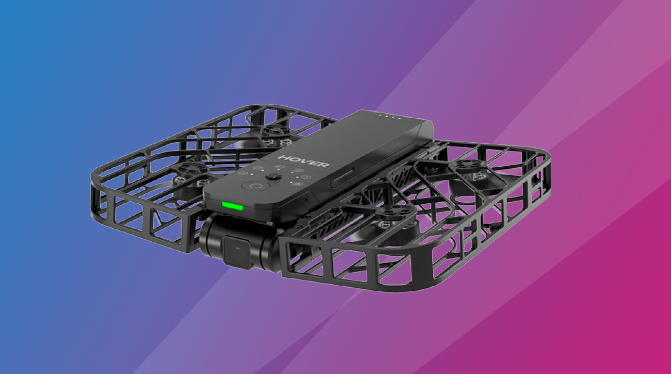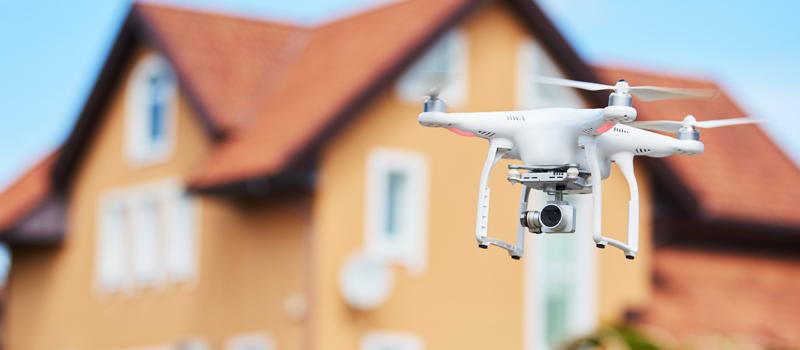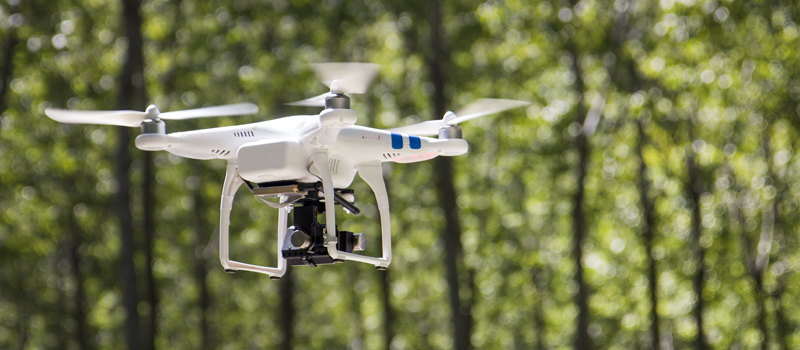-
Key Takeaways
-
What Is the Part 107 License?
-
Why Do You Need a Part 107 License?
-
Part 107 Eligibility Requirements
- Age and Language Proficiency
- Physical and Mental Fitness
-
Steps to Become a Certified Drone Pilot
- Step 1: Learn the Part 107 Rules
- Step 2: Obtain an FAA Tracking Number (FTN)
- Step 3: Prepare for the Aeronautical Knowledge Test
- Step 4: Register for the Aeronautical Knowledge Test
- Part 107 Knowledge Test Cost
- Step 5: Take and Pass the Part 107 Exam
- Step 6: Apply for Your Remote Pilot Certificate
-
Preparing for the Part 107 Exam
- Exam Topics and Structure
- Effective Study Strategies
- Sample Questions and Practice Exams
-
Operating Under the Part 107 License
- Drone Registration and Marking
- Understanding Operating Rules and Limitations
- Drone News Update
- Requesting Waivers and Airspace Authorizations
- Record Keeping and Documentation
-
Maintaining and Renewing Your Certification
- Recurrent Training Requirements
- Staying Updated with FAA Regulations
-
Frequently Asked Questions
-
Conclusion
Nowadays, it seems like there is an ever-growing list of sectors that are benefiting from commercial drone applications. Whether it is in heavy industries, real estate, cinematography, or delivery services, companies have become aware of how they can improve their processes with drones.
As a drone pilot, how can you get in on this action?
Well, it all has to start with getting your Part 107 license. This is a requirement in the United States for any type of commercial drone operation.
How can you earn a Part 107 license? How long will it take, and what are the costs associated with the process? Read on to find out!
Key Takeaways
- The Part 107 license is a requirement by the FAA for commercial drone operations in the US.
- There are eligibility requirements for the Part 107 license, which include passing a knowledge test.
- There is plenty of online material that can help you prepare for the Part 107 knowledge test.
- Being a Part 107 licensed pilot means you have to comply with operational rules and limits.
What Is the Part 107 License?
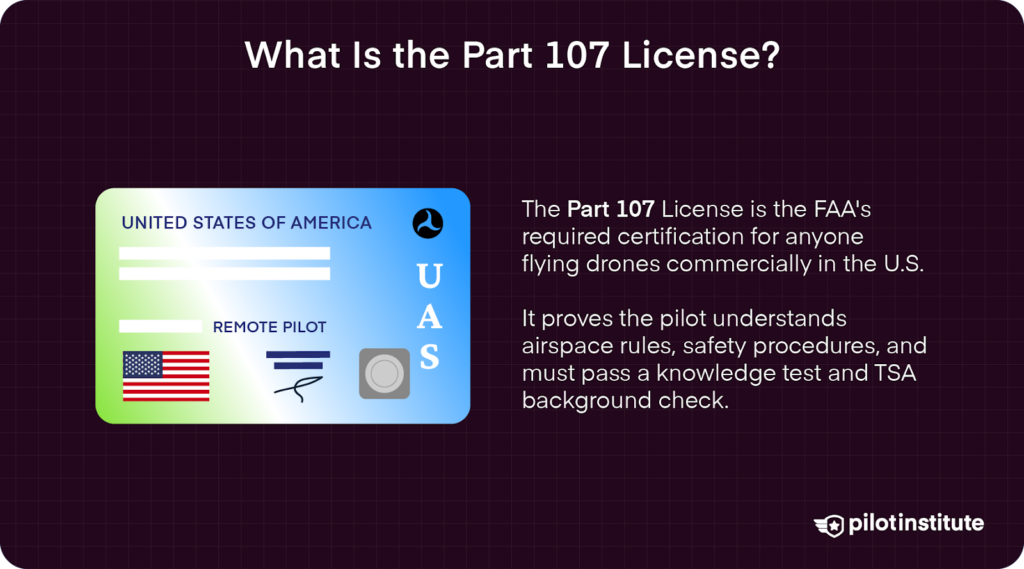
To give some context behind the Part 107 license, we must first understand what Part 107 is.
What is more commonly known as Part 107 refers to Part 107 of Title 14 of the Code of Federal Regulations (14 CFR), titled “Small Unmanned Aircraft Systems.”
What are these rules for?
Well, these are the rules that regulate commercial drone operations in the United States. The Federal Aviation Administration (FAA) is the governing body that has set and is implementing these rules.
Where does the Part 107 license come in?
The requirement for a remote pilot certificate or a “Part 107 license” is written under the Operating Rules section of Part 107. According to § 107.12, commercial drone operations must be conducted by a person with a remote pilot certificate or under the direct supervision of someone with the certificate.
We will go into the nuts and bolts of the Part 107 license, but if you plan to get one, you must first pass a knowledge test. This is one of the major goals of the Part 107 rules—making sure that pilots flying drones commercially are equipped with the knowledge to operate drones safely.
Why Do You Need a Part 107 License?
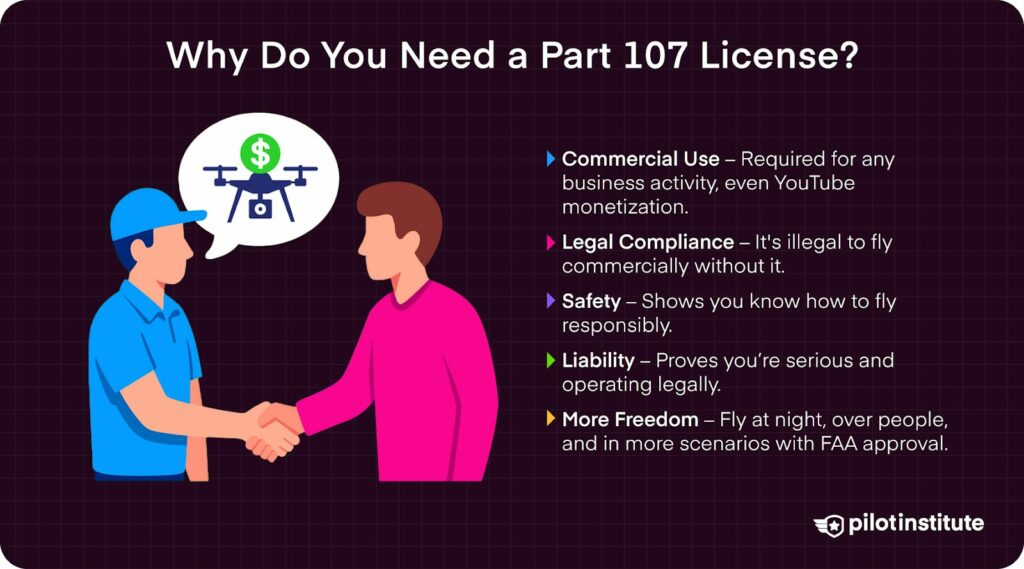
The language of the Part 107 rules states that a remote pilot certificate is a requirement to operate drones in the US, except if you are flying drones recreationally or for pleasure. The citation states:
“Any person who operates a civil sUAS in the NAS, for any operation that is not for recreational/pleasure purposes, must have a UAS pilot’s certificate (also called the “Part 107 Certificate”) with a Small Unmanned Aircraft System Rating.” (AIM, Chapter 11, Section 5)
What would happen if you fly a drone commercially without it? There is not a fixed penalty associated with flying a drone commercially without a license, but the FAA may consider it a civil penalty. This means that you can be fined anywhere between $1,100 to $75,000.
Are you planning to make money from flying your drone? A Part 107 license is a huge advantage as well, as it demonstrates your knowledge of the basics of aviation and industry best practices.
Aside from avoiding penalties, why else would you get a Part 107 license?
If you intend to earn money from flying your drone, having the license demonstrates knowledge of the aviation rules and industry best practices. This is a huge boost in credibility with potential clients and employers.
Being a licensed drone pilot also gives you access to insurance products that are offered only for commercial drone pilots. This can be very important in protecting you from financial risk, particularly from liability for any damage caused by drone accidents.
Part 107 Eligibility Requirements
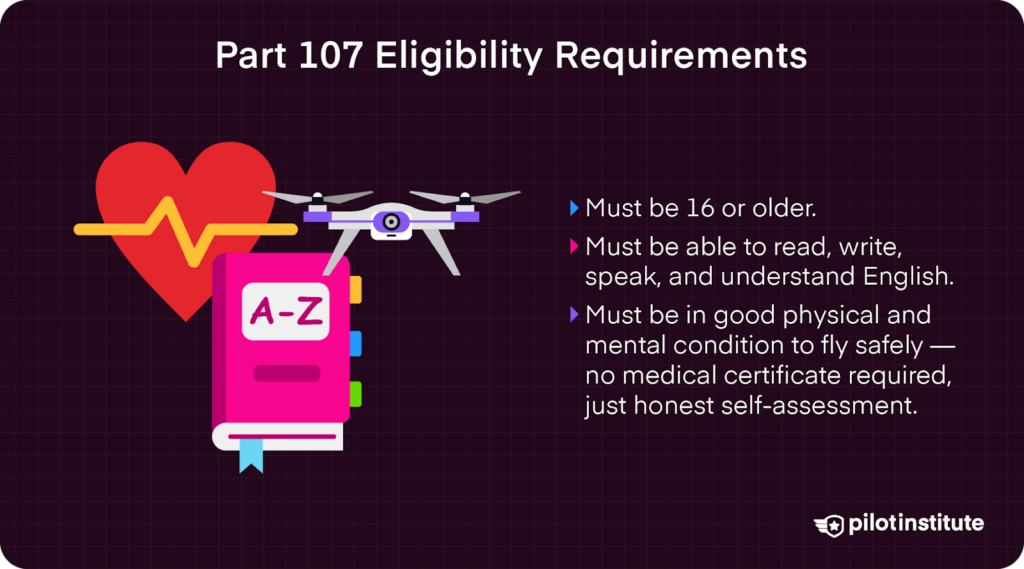
Age and Language Proficiency
Before you can apply for a Part 107 license, there are two very basic eligibility requirements:
- Be at least 16 years old.
- Be able to read, speak, write, and understand English.
- Be in a physical and mental condition that would not interfere with the operation of a small UAS.
Physical and Mental Fitness
The other part of the eligibility requirements is a little more open to interpretation. The rule states:
“Be in a physical and mental condition that would not interfere with the safe operation of a small UAS.” (AC 107-2A, Chapter 6)
There is no medicate certificate needed for those who want to apply for a Part 107 license, or for any type of commercial drone operations.
Instead, you only need to do a self-assessment and evaluate whether you are in a proper physical and mental condition to safely operate a drone.
Steps to Become a Certified Drone Pilot
Step 1: Learn the Part 107 Rules
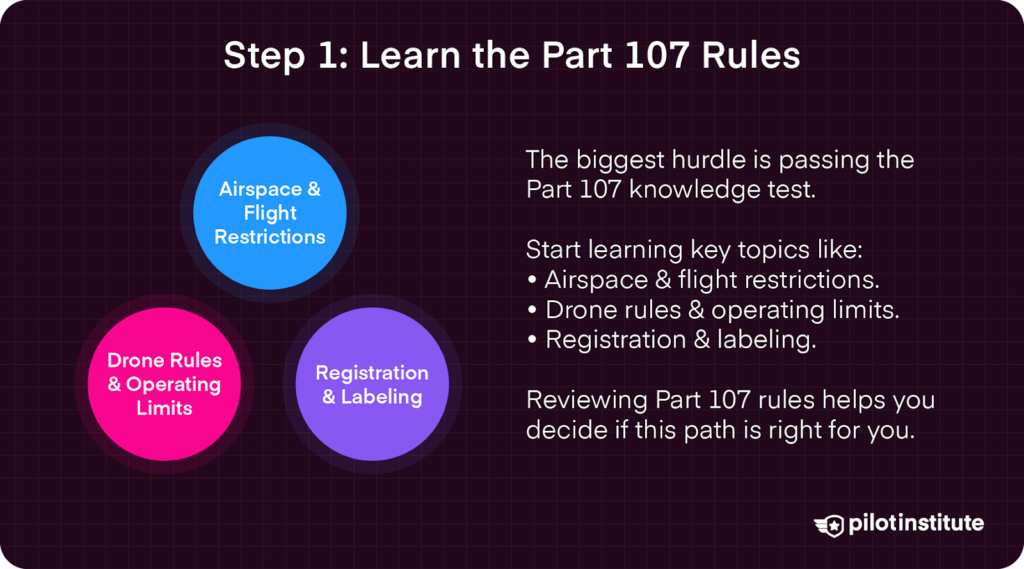
The major hurdle in getting a Part 107 license is passing the Part 107 knowledge test. This will require a very good level of knowledge of the Part 107 rules as well as concepts in aviation and weather.
At this point, it would be a good idea to familiarize yourself with the regulations and guidelines outlined in Part 107. Essential topics to start with would include:
- Airspace classification and restrictions.
- Operating requirements and limitations.
- Flight restrictions and prohibited areas.
- Drone registration and labeling.
Even just being familiar with the Part 107 rules will help you in knowing what you are getting into. This is also a good point to decide if a Part 107 license is indeed for you, despite all the regulations and requirements.
Step 2: Obtain an FAA Tracking Number (FTN)
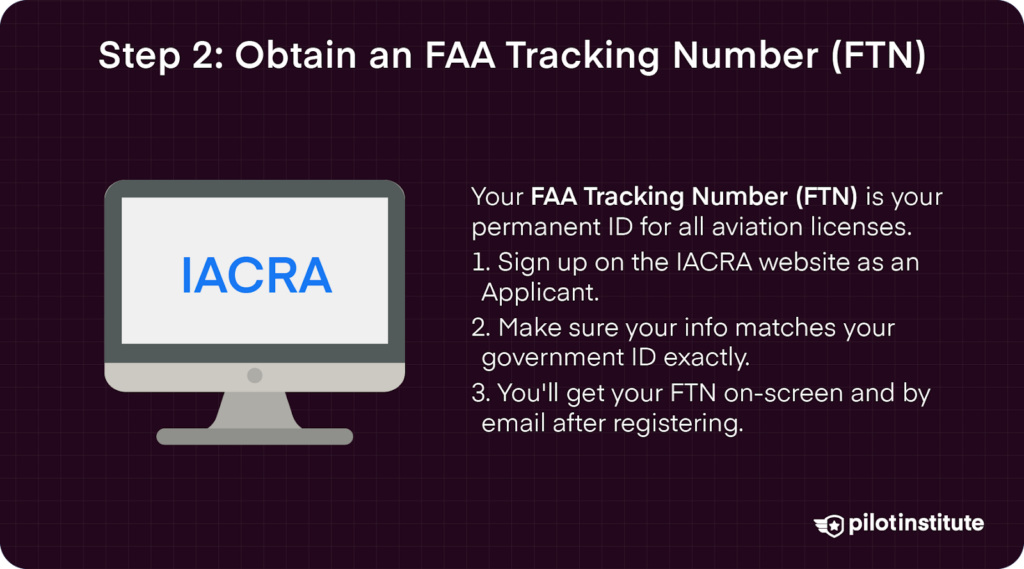
Are you now fully convinced that you want to get a Part 107 license? The first step would be to get your FAA Tracking Number (FTN).
The FTN is a unique identifier that will allow the FAA to record and monitor your progress throughout any aviation certification process. It is also permanent and will remain associated with you throughout your aviation career.
To get your FTN, simply go to the Integrated Airman Certification and Rating Application (IACRA) website and register for a new account.
Register as an Applicant, skip any sections that require you to input any Certificate Information, and fill out the fields on your personal details and contact information.
An important thing to remember is to make sure that the personal details you provide exactly match those on your government-issued ID.
Upon registering, you will be brought to a page that displays your username and FTN. These details will also be sent to you by email.
Step 3: Prepare for the Aeronautical Knowledge Test
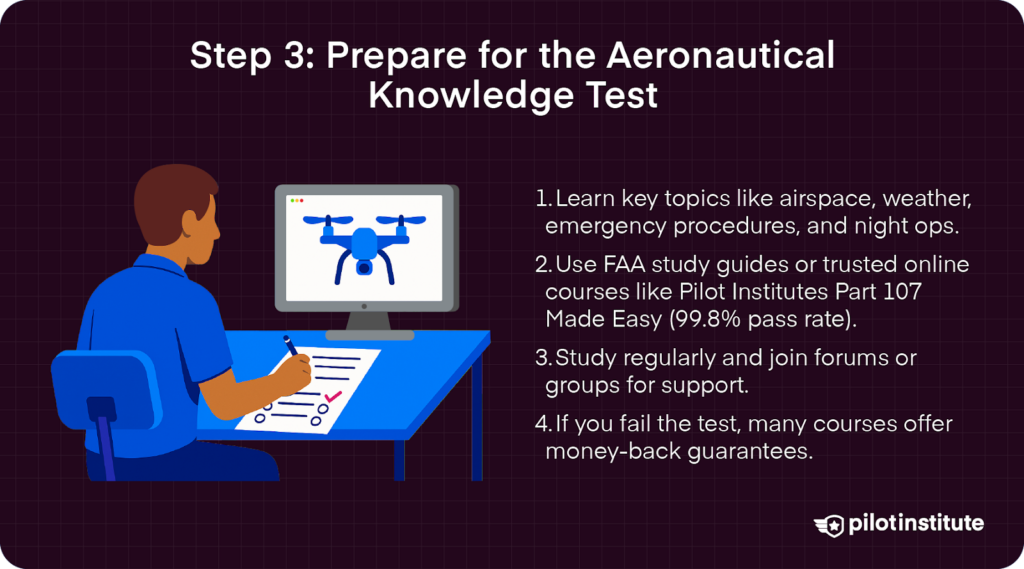
Now is the time to really hunker in and prepare for the Aeronautical Knowledge Test! There are many ways to do this and practically an endless list of online resources that could help you. But where should you start?
The FAA provides a good outline of the topics that will be covered in the knowledge test. Here is what the FAA says:
“The knowledge test will cover the aeronautical knowledge areas listed below:
- Applicable regulations relating to small UAS rating privileges, limitations, and flight operation;
- Airspace classification, operating requirements, and flight restrictions affecting small unmanned aircraft operations;
- Aviation weather sources and effects of weather on small unmanned aircraft performance;
- Small unmanned aircraft loading;
- Emergency procedures;
- Crew resource management (CRM);
- Radio communication procedures;
- Determining the performance of the small unmanned aircraft;
- Physiological effects of drugs and alcohol;
- Aeronautical decision-making (ADM) and judgment;
- Airport operations;
- Maintenance and preflight inspection procedures; and
- Operation at night.” (AC 107-2A, Chapter 6)”
The FAA also has official study materials that are quite comprehensive:
- Remote Pilot – Small Unmanned Aircraft Systems Study Guide (FAA-G-8082-22)
- Remote Pilot – Small Unmanned Aircraft System Airman Certification Standards (FAA-S-ACS-10B)
There are various online courses, video tutorials, sample tests, and other study aids that have been created through the years and are available online.
Our own Part 107 Made Easy course has been completed by more than 100,000 students and maintains a 99.8% passing rate. If you don’t pass the Part 107 knowledge test on your first try, then you get your money back.
No matter what study material you choose to use, it is important to develop a routine and do your study sessions regularly. You will need to go through plenty of material, and the best way to remember them would be to study slowly and consistently.
It is also a good idea to join study groups or online forums that can provide support throughout the process.
Step 4: Register for the Aeronautical Knowledge Test
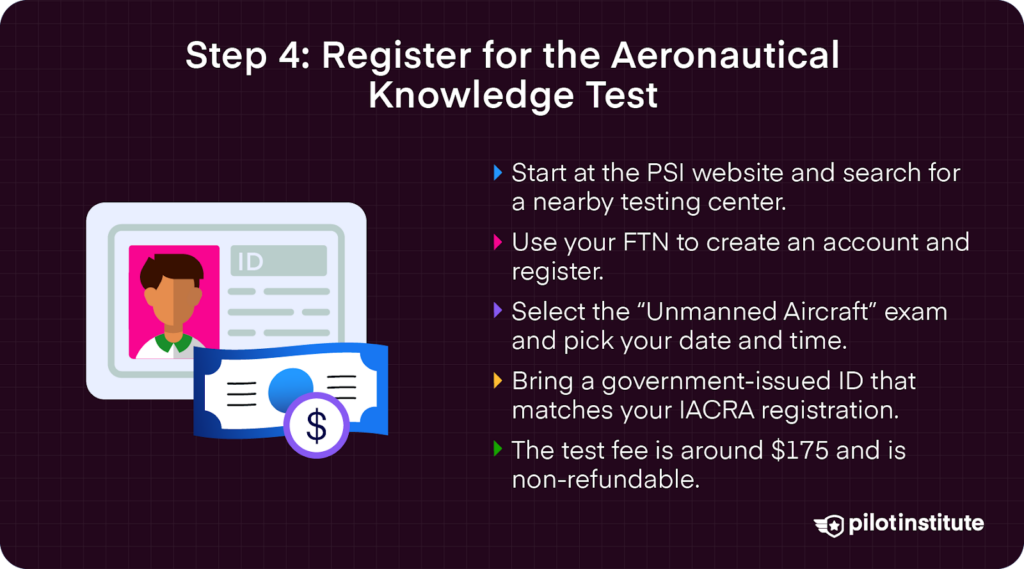
Once you feel that you are ready, you can register to take the Aeronautical Knowledge Test. The test is administered by PSI Services LLC, the official testing vendor of the FAA.
The first step would be to go to the PSI website and search for a testing center that is near you.
You will need to specify your postal code, country, preferred search radius, and the type of exam you are taking on the Testing Center Locator page. You will then be presented with a list of different testing centers with their names and addresses.
Once you have selected your testing center, you will need to provide your FTN to proceed with the registration. The website will also show you some of the eligibility requirements for the test and the documents that you will need to present.
NOTE: You will also need to create an account on the PSI website that is connected to your FTN.
After registration, you will be presented with a long list of exams that you can take. Make sure to choose the option for Unmanned Aircraft. You will then be taken to the main schedule selection page or you can browse for nearby testing centers.
Go through all the options and select your preferred testing center, date, and time. Be extra careful when making your selection!
Part 107 Knowledge Test Cost
There is a non-refundable fee for the Part 107 knowledge test, which is around $175.
Remember to bring a government-issued ID that matches the information on your IACRA registration when taking the test!
Step 5: Take and Pass the Part 107 Exam
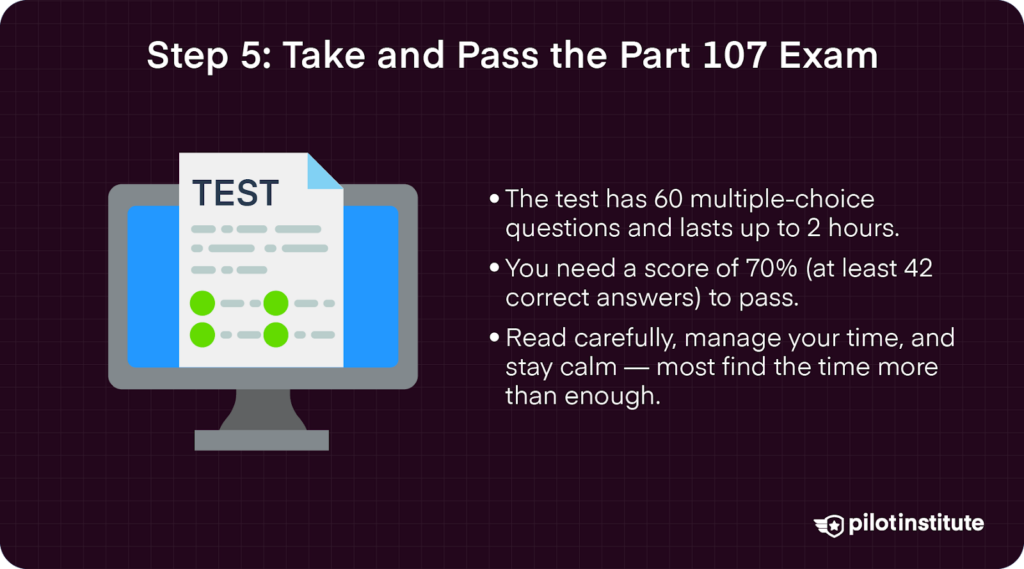
All you need to do now is to show up at your testing center at the schedule that you chose. It will be good to arrive early so you can get settled in before the test starts. Take note again of the requirement to present a government-issued ID.
Here are some of the basic things you need to know about the Part 107 exam:
- It is a 60-item multiple-choice exam.
- You are given a maximum of 2 hours to complete the test.
- To pass the test, you need to get a score of 70% or higher. As of September 2021, the test has 60 questions, meaning you need at least 42 correct answers.
The typical tips for any test will apply to the Part 107 knowledge test. Read each question carefully, noting the important keywords, numbers, and figures. If there are questions that you are struggling with, it’s best to mark them and leave them for later so that you don’t waste time.
Most importantly, don’t panic!
If you studied plenty of material and online courses, then you should do well in the test. Most people who passed the test say that the 2-hour time limit is way more than enough. Take it slowly and carefully, do not rush, but also manage your time in a smart way.
Step 6: Apply for Your Remote Pilot Certificate
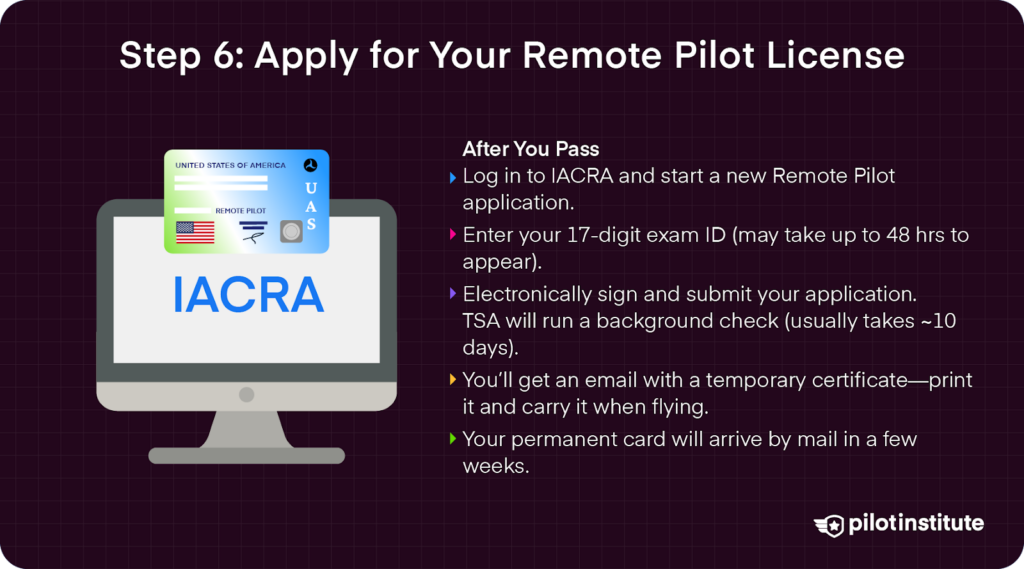
You should be notified shortly if you have passed the test. In which case, congratulations! There are just a few more steps before you can start flying drones commercially.
After passing your test, do these:
- Log in to your IACRA account.
- Click on “Start a new application.”
- Proceed with the next steps and apply for the “Remote Pilot” certification.
- When prompted, enter your 17-digit Knowledge Test Exam ID.
NOTE: It may take up to 48 hours before your knowledge test appears on the IACRA.
Sign the application electronically and then submit it for processing.
Your application will then be endorsed for a TSA security background check. You don’t have to do anything during this part except to wait for the result. After the back check, you should receive an email with instructions for printing a temporary remote pilot certificate.
The time it takes to complete the TSA background check varies case to case, but nowadays it takes about 10 days.
The temporary remote pilot certificate already gives you all the privileges of the Part 107 license. Print this out, keep it in your wallet, and always bring it with you when flying your drone commercially. Meanwhile, your permanent remote pilot certificate will be mailed to you after a few weeks.
Preparing for the Part 107 Exam
Exam Topics and Structure
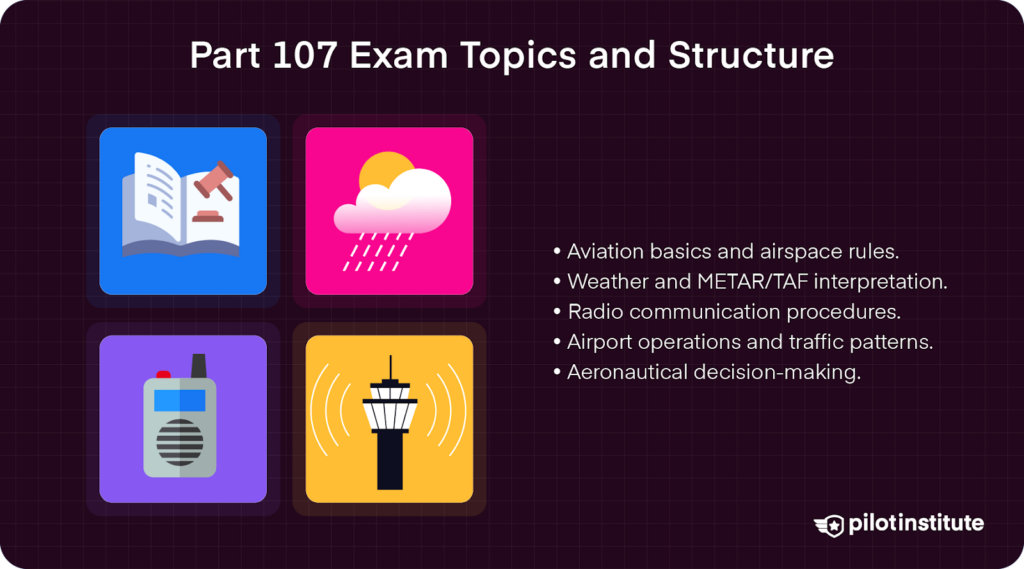
The Part 107 knowledge test is designed to ensure that all licensed drone pilots know about the rules and restrictions, as well as the basic concepts of topic such as:
- Aviation
- Weather
- Radio Communications
- Airport Operations
- Decision-Making
Some of the topics may seem deceptively simple but will require developing familiarity with some aviation-specific terms. For example, you might have some understanding of weather conditions but will probably not be able to interpret METAR or TAF messages.
This means that it will not be enough to rely on what you already know – a lot of studying will be needed.
Most of the topics covered by the knowledge test are considered very important and will come in handy regularly in your drone operations. Some of the more practical applications include:
- Knowing about airspace classifications and how to read sectional charts.
- Knowing about possible visual illusions when flying a drone at night.
- Learning how to communicate using standard radio language.
These are all equally important and deserve your attention during the preparation period.
Effective Study Strategies
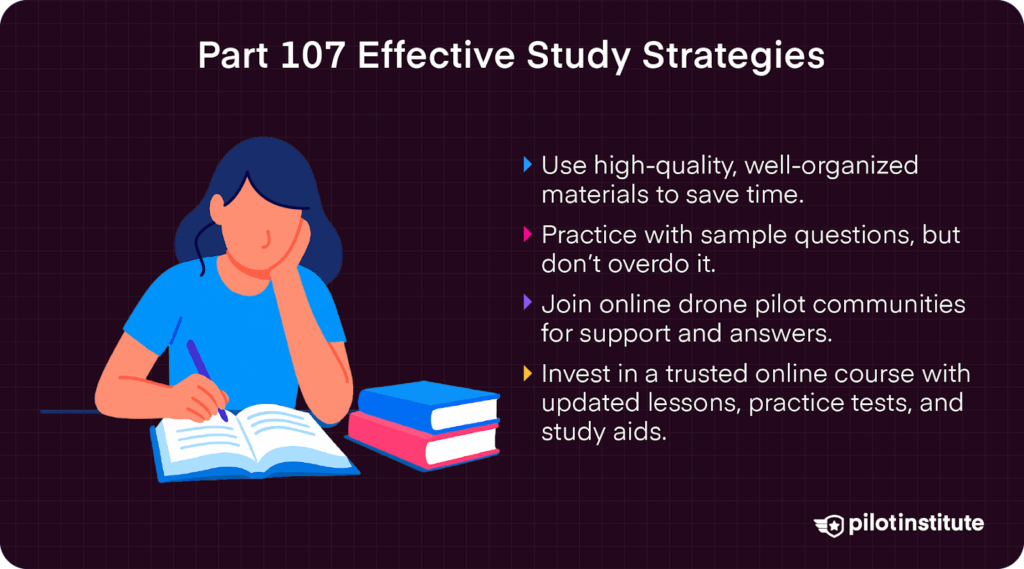
The effectiveness of your study sessions is only as good as the quality of the material you are studying. Material that is explained and organized well also saves you time, as you will not need to go through the same topics all over again.
It would also be good to go through 2 or 3 sample questions and online quizzes. This is a good way to familiarize yourself with the type of questions that will be at the knowledge test.
Some skills, like reading sectional charts or making calculations on weight and balance, are developed best when practiced. However, be careful not to overdo it, as taking a lot of these sample tests can also take up a lot of time.
It would be helpful to be part of an online community of drone pilots that you can ask if there are topics that are unclear to you. The community members can also support you through the process, and this could be an invaluable boost for what could be a high-stress situation.
Our recommendation?
Sign up for an online Part 107 course with a provider that has an excellent reputation. These courses are often paid but are not very expensive.
They are well worth the money as these will give you access to plenty of high-quality and updated study material. Look for an online course that also gives you sample tests, flash cards, and “cram sheets.”
Sample Questions and Practice Exams
As we already said, sample questions and practice tests are very useful tools to help you prepare. Some of the sample questions floating around online almost exactly mimic the questions that are in the Part 107 knowledge test.
When doing practice tests, we recommend that you go through exercises that require you to look up a document or perform multi-step analysis.
Some classic examples of this would be questions on reading sectional charts, interpreting weather reports, or identifying controlled airspace.
There are plenty of good sources for sample Part 107 exams online. You can even get one from the FAA. I
In most cases, high-quality Part 107 online courses would also have equally good practice tests that come with well-explained answer keys. It’s worth going through these blind and doing an analysis on the items you got wrong after.
Operating Under the Part 107 License
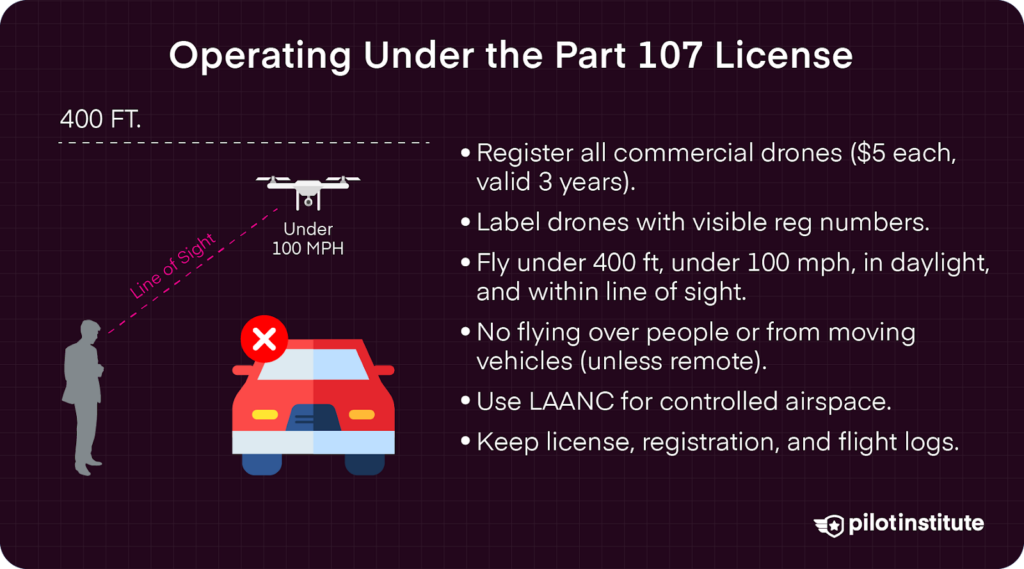
Drone Registration and Marking
All drones used commercially will need to be registered with the FAA, regardless of weight. This means that it covers even the small drones that weigh less than 250 grams. If the drone weighs under 250 grams and is used recreationally, then it does not need to be registered.
The good news is that drone registration is just as easy as it has ever been. Just go to the FAADroneZone website, sign up for an account, and start registering your drones under Part 107 rules. There is a registration fee of $5 per drone, and this will be valid for 3 years.
Upon registering, each one of your drones will be assigned a registration number.
What are you expected to do with this registration number?
As part of Part 107 says, you will need to mark each drone with its corresponding number in a manner that is legible and durable. The number must also be easily visible upon inspection of the drone’s external surface.
The easiest way to do this is with a high-quality sticker, but some drone pilots have also taken to engraving the registration numbers.
Understanding Operating Rules and Limitations
While there is a wide selection of rules under Part 107, its most basic framework is the operating rules and limitations on commercial drone flight. Most of these rules also apply to recreational drone flight, so it’s worth knowing them no matter how you choose to fly your drone
The key regulations to follow are as follows:
- Fly at or below 400 feet AGL (above ground level) in Class G airspace.
- Maintain a maximum speed of 100 mph.
- Fly within visual line of sight.
- Fly during daylight hours or civil twilight with appropriate anti-collision lighting.
- Yield right of way to manned aircraft.
- Do not fly over people who are not directly participating in the operation.
- Do not fly from a moving vehicle unless in a sparsely populated area.
- Never operate in a careless or reckless manner.
As a commercial drone pilot, it is worth noting that it is possible to apply for a waiver for these operating limitations.
However, you will need to provide measures to keep your operations safe, despite flying outside some of the rules. For instance, you can fly a drone beyond visual line of sight as long as the operations are kept within a restricted and unpopulated area.
Requesting Waivers and Airspace Authorizations
Applying for waivers can be a long and involved process. It mostly involves a significant amount of paperwork, which shows your ability to anticipate potential issues and implement appropriate mitigating measures.
Fortunately, you no longer need a waiver to fly your drone in controlled airspace.
To simplify this process, the FAA has come up with the Low Altitude Authorization and Notification Capability (LAANC) system. This is a system that consolidates all airspace authorization requests for drone flight and provides near real-time response.
Better yet, you can submit LAANC requests using some of the most common drone flight planning apps.
Record Keeping and Documentation
The Part 107 rules place a small amount of emphasis on the importance of record-keeping and documentation. While not specifically a requirement under Part 107, documentation is a great way to keep track of your drone flight experience, thus also boosting your reputation as a commercial drone pilot.
Make sure to keep any records of transactions made with the FAA. Whenever you fly your drone commercially, try and have these documents with you:
- Your Part 107 license.
- Your drone registration.
- Any relevant waiver applications.
Aside from the bare minimum of recordkeeping, we highly suggest keeping a log of flight times, incidents, and maintenance activities.
You can choose to do this the old-fashioned way with a physical logbook. There are also digital solutions which may be more convenient and accessible.
Maintaining and Renewing Your Certification
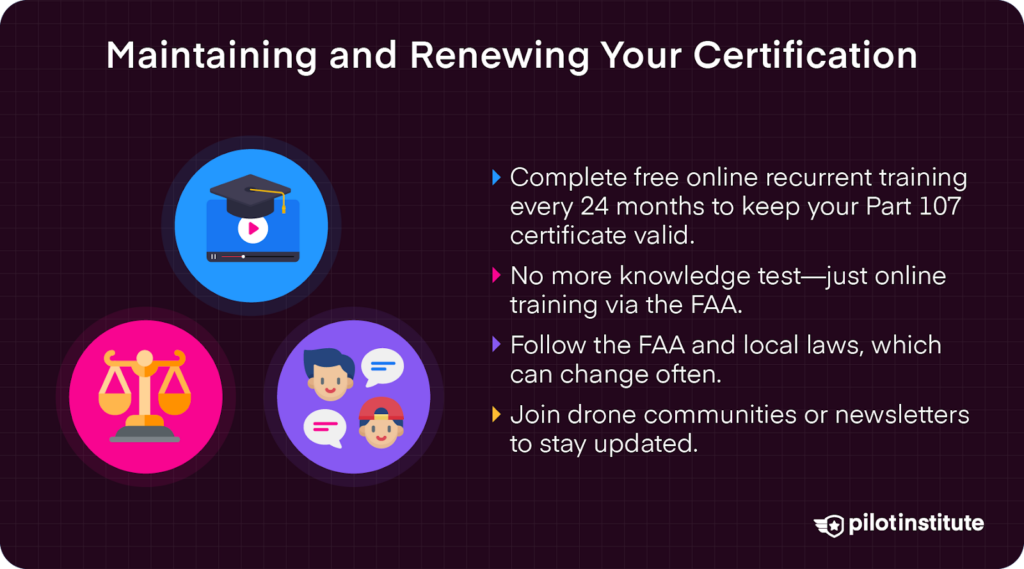
Recurrent Training Requirements
Does your Part 107 license expire?
It technically does not, but licensed pilots are required to keep their certificates current by completing a recurrent online training every 24 calendar months.
This is a way to ensure the pilots licensed under Part 107 maintain the level of knowledge required for safe drone operations. The recurrent online training is free.
As of April 2021, the online recurrent training has replaced the need to take a recurrent knowledge test. This has made it a lot more convenient for Part 107 licensed pilots to maintain their currency.
The steps on taking the online recurrent training for Part 107 are detailed on the FAA’s website.
Explain that Remote Pilots must complete recurrent online training every 24 calendar months to maintain certification.
Staying Updated with FAA Regulations
Laws change all the time. The regulation of drone flight can still be considered to be in its early stages, so major changes in rules can happen multiple times a year. With this in mind, it is very important for Part 107 licensed pilots to stay informed on regulatory changes, advisories, and safety notices.
Make sure to subscribe to the FAA updates and follow the FAA on all their official social media channels. This would also be a good reason to join a drone community, whether in-person or online, to keep up with discussions on changing drone rules.
Aside from FAA rules, new local laws and state laws may influence how you can fly your drone. This can be a little harder to follow but is just as important, especially if you run a drone business or fly your drone regularly within a certain region.
Keeping up with all these changes can be hard! It is a huge help to be part of a community of drone pilots or signing up to a newsletter that can provide updated information. These can also be great venues for discussion or sources of insights on new laws.
Frequently Asked Questions
This section is for directly addressing some of the most common questions we have received about Part 107. Some of these have already been answered above, but we will provide direct answers here nonetheless.
- How hard is it to get a Part 107 license?
More than 400,000 commercial drone pilots have been certified since the Part 107 rules were introduced. This rapidly growing number is a sign that there is not a huge skill or knowledge hurdle in getting a Part 107 license.
You will still need to spend substantial time preparing for the knowledge test, but the test itself is only moderately difficult, and all the material you will need can be found online.
- How much does it cost to get a Part 107 license?
Technically, the only amount you need to pay is the $175 fee for the Part 107 knowledge test.
You have the option of using free material to prepare for the knowledge test. There is plenty of material online that you do not have to pay for.
However, if you really want to take a career in drone flight seriously, we highly recommend signing up for a high-quality Part 107 course.
An online Part 107 course does not have to be expensive. Our Part 107 Made Easy course provides lifetime access to high-quality and up-to-date material at a discounted price of only $159. It costs even less than the knowledge test!
- What is the hardest part of the Part 107 test?
There is obviously no straightforward answer to this question, as people with different backgrounds will likely find difficult topics challenging.
However, a huge majority of people who have taken the Part 107 knowledge test will say that the topics they struggled the most with are airspace and reading sectional charts.
Reading all of the numbers and codes on a sectional chart is quite tricky and can get quite overwhelming.
Pay special attention to this topic while you’re studying, and go through as many sample questions as you can.
- How long does it take to get a Part 107 license?
Again, this is a question that can have answers that will vary from one case to another.
There are some answers that are more definitive – the results of the knowledge test can be expected between 48 to 72 hours, while the TSA background check should not last more than two weeks.
The time that you will spend preparing for the knowledge test is entirely up to you.
Most people say that it took them between 2-4 weeks to prepare for the test, spending about 2 to 6 hours per day studying. This seems like a reasonable and realistic estimate.
All in all, you can get your Part 107 license test in about one to two months.
Conclusion
Obtaining a Part 107 license might seem like a challenge, but you can simplify it to just a few steps: learn the Part 107 rules, obtain an FTN, spend some time studying, take and pass the knowledge test, and apply for a certificate.
You will have to do a bit of work to learn all the concepts needed to pass the Part 107 knowledge test, but the license is certainly worth the effort. A remote pilot certificate opens the doors to a rewarding career in commercial drone flight.
This is a rapidly growing industry, and getting started sooner rather than later puts you in a better position for success.
Are you also aspiring to be a commercial drone pilot? Now would be a great time to read up more about Part 107 on the FAA’ s website or enroll in an online training course. And schedule your Part 107 knowledge test soon!
